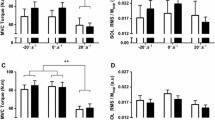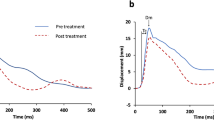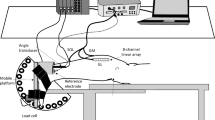Abstract
The present study deals with the question whether 24-week strength training alters neuromechanical properties of plantar flexors in elderly people (73–83 years). The first purpose of the present study was to evaluate the effect of strength training on musculotendinous (MT) stiffness of the triceps surae (TS). The training was performed twice per week and mainly consisted of three series of ten repetitions of calf-rise and leg-press exercises at 75% of the three-repetition maximum. Using quick-release movements at different levels of submaximal torques performed measurements of MT stiffness. Surface electromyograms (EMG) of each part of the TS and the tibialis anterior were also recorded. A stiffness index (SI), defined as the slope of the angular stiffness–torque relationship (SIMT-Torque), was used to quantify changes in MT stiffness. Results showed a significant decrease in SIMT-Torque by 25.2% following training (P<0.05). The second purpose of the study was to evaluate whether neural mechanism has influences on this decrease. Therefore, an activation SI, defined as the slope of the angular stiffness–EMG relationship (SIMT-EMG) was used to overcome the influence of changes in agonist activity, and thus to quantify changes in MT intrinsic elastic properties. SIMT-EMG only decreased by 11.2% following training (P<0.05). The present results underlined that MT stiffness decreases following training in elderly individuals, counterbalancing the effect of ageing. These changes seem not only to be due to peripheral but also to neural adaptations.





Similar content being viewed by others
References
Blanpied P, Smidt GL (1993) The difference in stiffness of the active plantar flexors between young and elderly human females. J Gerontol 48:58–63
Cresswell AG, Loscher WN, Thorstensson A (1995) Influence of gastrocnemius muscle length on triceps surae torque development and electromyographic activity in man. Exp Brain Res 105:283–290
Ferri A, Scaglioni G, Pousson M, Capodaglio P, Van Hoecke J, Narici MV (2003) Strength and power changes of the human plantar flexors and knee extensors in response to resistance training in old age. Acta Physiol Scand 177:69–78
Frontera WR, Hughes VA, Krivickas LS, Kim SK, Foldvari M, Roubenoff R (2003) Strength training in older women: early and late changes in whole muscle and single cells. Muscle Nerve 28:601–608
Goubel F, Pertuzon E (1973) Evaluation de l’élasticité du muscle in situ par une mèthode de quick-release. Arch Int Physiol Biochim Biophys 81:697–707
Häkkinen K, Kallinen M, Izquierdo M, Jokelainen K, Lassila H, Malkia E, Kraemer WJ, Newton RU, Allen M (1998) Changes in agonist-antagonist EMG, muscle CSA, and force during strength training in middle-aged and older people. J Appl Physiol 84:1341–1349
Hill AV. (1950) The series elastic component of muscle. Proc R Soc Lond B Biol Sci 137:273–280
Huxley AF, Simmons RM. (1971) Mechanical properties of the cross-bridges of frog striated muscle. J Physiol (Lond) 218:59–60
Jones DA, Rutherford OM. (1987) Human muscle strength training: the effects of three different regimens and the nature of the resultant changes. J Physiol (Lond) 391:1–11
Kubo K, Kanehisa H, Ito M, Fukunaga T (2001a) Effects of isometric training on the elasticity of human tendon structures in vivo. J Appl Physiol 91:26–32
Kubo K, Kanehisa H, Fukunaga T (2001b) Effects of different duration isometric contractions on tendon elasticity in human quadriceps muscles. J Physiol 536:649–655
Kubo K, Kanehisa H, Fukunaga T (2002) Effects of resistance and stretching training programmes on the viscoelastic properties of human tendon structures in vivo. J Physiol 538:219–226
Kubo K, Kanehisa H, Miyatani M, Tachi M, Fukunaga T (2003) Effect of low-load resistance training on the tendon properties in middle-aged and elderly women. Acta Physiol Scand 178:25–32
Lambertz D, Perot C, Kaspranski R, Goubel F (2001) Effects of long-term spaceflight on mechanical properties of muscles in humans. J Appl Physiol 90:179–188
Lambertz D, Mora I, Grosset JF, Perot C (2003) An evaluation of musculo-tendinous stiffness in prepubertal children and adults, taking into account muscle activity. J Appl Physiol 95:64–72
Lexell J, Downham DY, Larsson Y, Bruhn E, Morsing B (1995) Heavy-resistance training in older Scandinavian men and women: short- and long-term effects on arm and leg muscles. Scand J Med Sci Sports 5:329–341
Moritani T, deVries HA. (1979) Neural factors versus hypertrophy in the time course of muscle strength gain. Am J Phys Med 58:115–130
Narici MV, Hoppeler H, Kayser B, Landoni L, Claassen H, Gavardi C, Conti M, Cerretelli P (1996) Human quadriceps cross-sectional area, torque and neural activation during 6 months strength training. Acta Physiol Scand. 157:175–186
Ochala J, Lambertz D, Pousson M, Goubel F, Van Hoecke J (2004) Changes in mechanical properties of human plantar flexor muscles in ageing. Exp Gerontol 39:349–358
Poulain P, Pertuzon E (1988) Etude comparative des effets de trois méthodes de musculation sur les propriétés contractiles et élastiques du muscle. Ann Kinesi ther 15:167–177
Pousson M, Van Hoecke J, Goubel F (1990) Changes in elastic characteristics of human muscle induced by eccentric exercise. J Biomech 23:343–348
Reeves ND, Narici MV, Maganaris CN (2003) Strength training alters the viscoelastic properties of tendons in elderly humans. Muscle Nerve 28:74–81
Sale DG (1988) Neural adaptation to resistance training. Med Sci Sports Exerc 20:135–145
Sale D, Quinlan J, Marsh E, McComas AJ, Belanger AY (1982) Influence of joint position on ankle plantar flexion in humans. J Appl Physiol. 52:1636–1642
Scaglioni G, Ferri A, Minetti AE, Martin A, Van Hoecke J, Capodaglio P, Sartorio A, Narici MV. (2002) Plantar flexor activation capacity and H reflex in older adults: adaptations to strength training. J Appl Physiol 92:2292–2302
Tognella F, Mainar A, Vanhoutte C, Goubel F (1997) A mechanical device for studying mechanical properties of human muscles in vivo. J Biomech 30:1077–1080
Toursel T, Stevens L, Mounier Y (1999) Evolution of contractile and elastic properties of rat soleus muscle fibres under unloading conditions. Exp Physiol 84:93–107
Trappe S, Williamson D, Godard M, Porter D, Rowden G, Costill D (2000) Effect of resistance training on single muscle fiber contractile function in older men. J Appl Physiol 89:143–152
Trappe S, Godard M, Gallagher P, Carroll C, Rowden G, Porter D (2001) Resistance training improves single muscle fiber contractile function in older women. Am J Physiol Cell Physiol 28:398–406
Valour D, Pousson M (2003) Compliance changes of the series elastic component of elbow flexor muscles with age in humans. Pflugers Arch 445:721–727
Wickiewicz TL, Roy RR, Powell PL, Perrine JJ, Edgerton VR (1984) Muscle architecture and force-velocity relationships in humans. J Appl Physiol. 57:435–443
Woo SL, Ritter MA, Amiel D, Sanders TM, Gomez MA, Kuei SC, Garfin SR, Akeson WH (1980) The biomechanical and biochemical properties of swine tendons–long term effects of exercise on the digital extensors. Connect Tissue Res 7:177–183
de Zee M, Voigt M (2001) Moment dependency of the series elastic stiffness in the human plantar flexors measured in vivo. J Biomech 34:1399–1406
de Zee M, Voigt M (2002) Assessment of functional series elastic stiffness of human dorsiflexors with fast controlled releases. J Appl Physiol 93:324–329
Acknowledgements
The authors thank Yves Ballay for technical assistance and the participants in the Better Ageing program. This work was supported by grants from the European Commission (Framework Program V, QLRT-2001-00323).
Author information
Authors and Affiliations
Corresponding author
Rights and permissions
About this article
Cite this article
Ochala, J., Lambertz, D., Hoecke, J.V. et al. Effect of strength training on musculotendinous stiffness in elderly individuals. Eur J Appl Physiol 94, 126–133 (2005). https://doi.org/10.1007/s00421-004-1299-7
Received:
Accepted:
Published:
Issue Date:
DOI: https://doi.org/10.1007/s00421-004-1299-7




